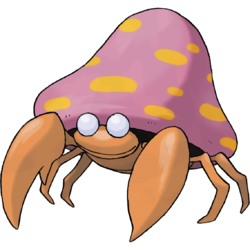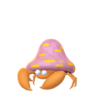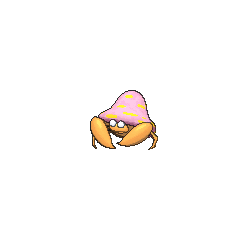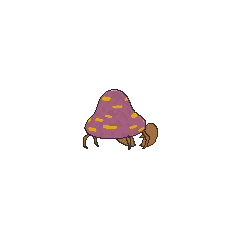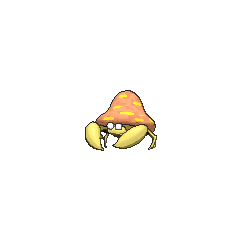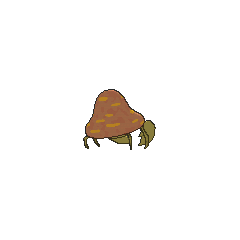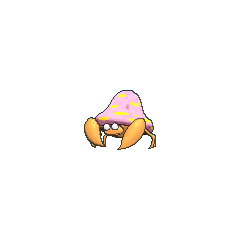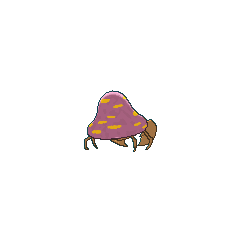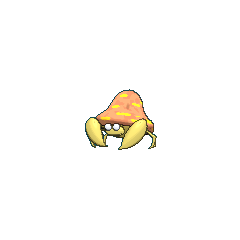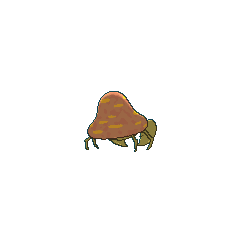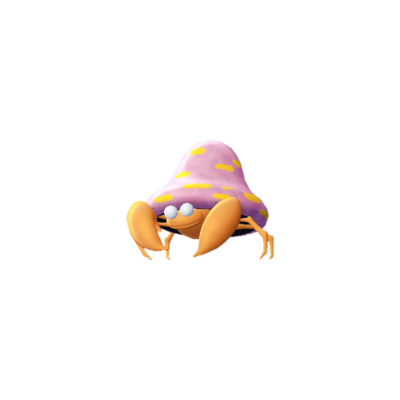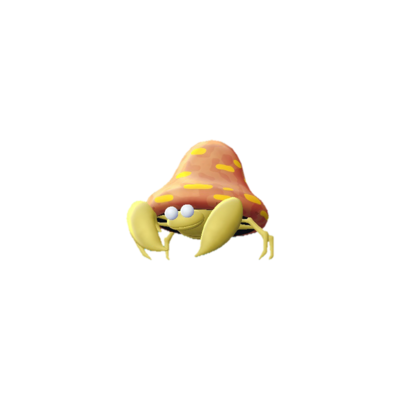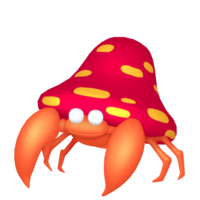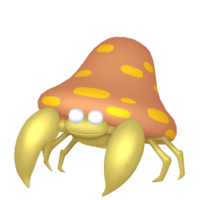Parasect (Japanese: パラセクト Parasect) is a dual-type Bug/Grass Pokémon introduced in Generation I.
It evolves from Paras starting at level 24.
Biology
Parasect is an orange, insectoid Pokémon that has been completely overtaken by the parasitic mushroom on its back. It has a small head with pure white eyes and a segmented body that is mostly hidden by the mushroom. It has three pairs of legs with the foremost pair forming large pincers. The fungus growing on its back has a large red cap with yellow spots throughout.
The insect has been drained of nutrients and is now under the control of the fully-grown tochukaso. Removing the mushroom will cause Parasect to stop moving. It can thrive in dark forests with a suitable amount of humidity for growing fungi. Swarms of this Pokémon have been known to infest trees. The swarm will drain the tree of nutrients until it dies and will then move on to a new tree. It has been known to fight with Shiinotic over territory. Prior to Generation III, Spore was its signature move.
In the anime
Major appearances
In The Problem with Paras, Cassandra's Parasect was initially a very weak Paras. Cassandra needed it to evolve into a Parasect so she can use its giant mushroom to aid her in her medical research. After battles with most of Ash's Pokémon and Team Rocket, Paras evolved.
In Hocus Pokémon, Lily needed Stun Spore from a Parasect to complete a spell.
In Gulpin it Down, an Officer Jenny used a Parasect in addition to her Meganium and Tangela during an effort to stop the massive army of Gulpin that was rioting around the town.
In Working My Way Back to Mew!, Goh caught a Parasect. It has since made further appearances in Pokémon Journeys: The Series.
Minor appearances
In A Chansey Operation, an injured Parasect was brought to the clinic.
In Princess vs. Princess, a Parasect competed in the Queen of the Princess Festival.
In Pikachu's Vacation, a Parasect was at the Pokémon Theme Park.
In Showdown at the Po-ké Corral, multiple Parasect were living at Professor Oak's Laboratory.
In Friends to the End, a Trainer's Parasect was at the closing ceremonies of the Indigo Plateau Conference.
In The Power of One, a Parasect sensed the disturbance caused by Lawrence III.
A wild Parasect appeared in Pikachu's Rescue Adventure.
A Parasect appeared in a fantasy in The Rivalry Revival.
Multiple Parasect appeared in Celebi: The Voice of the Forest.
In Throwing in the Noctowl, a Parasect was living at Wings Alexander's barn.
In For Ho-Oh the Bells Toll!, multiple Parasect protected the Tin Tower after Team Rocket stole the Crystal Bells on the top floor.
In Showdown at the Oak Corral, a Parasect was living at Professor Oak's Laboratory.
Multiple Parasect appeared in Destiny Deoxys.
A Parasect appeared in the opening sequence of Lucario and the Mystery of Mew.
In Pokémon Ranger and the Temple of the Sea, The Phantom used a Parasect alongside a Pinsir to attack Jack Walker.
A Parasect appeared in The Keystone Pops!.
In Genesect and the Legend Awakened, a Parasect was a resident of Pokémon Hills.
A Trainer's Parasect appeared in Alola to New Adventure! and First Catch in Alola, Ketchum-Style!.
In Lillie's Egg-xhilarating Challenge!, a Parasect was playing in Lillie's garden.
A Trainer's Parasect appeared in I Choose You!.
In Currying Favor and Flavor!, a Parasect used Stun Spore on Ash and Mallow as they searched for a Mago Berry.
Six Parasect appeared in The Power of Us, with four under the ownership of Trainers and the other two being wild.
Three Parasect appeared in Securing the Future!, with two under the ownership of different Trainers and the third being wild. They joined the rest of Alola in showering Necrozma with light so it could return to its true form.
A Trainer's Parasect appeared in League Offenders and Defenders!.
In Battle Royal 151!, a Trainer's Parasect competed in the Battle Royal preliminary round of the Manalo Conference but ended up losing.
In The Battlefield of Truth and Love!, a Parasect was watching Bewear and Stufful put on a performance in their hot springs.
Two Parasect appeared in Trade, Borrow, and Steal!, with one under the ownership of a Trainer and the other being wild.
A Trainer's Parasect appeared in Take My Thief! Please!.
A Trainer's Parasect appeared in Ultra Exciting from the Shocking Start!.
Pokédex entries
| Episode
|
Pokémon
|
Source
|
Entry
|
| EP044
|
Parasect
|
Ash's Pokédex
|
Parasect, the Mushroom Pokémon. It battles using poison spheres that spread from the mushroom canopy on its back.
|
|
In the manga
Pokémon Adventures
Parasect debuted in Long Live the Nidoking!, where it was seen as one of the Pokémon at Fuchsia City's Safari Zone.
Crystal has a Parasect nicknamed Parasee, which first appeared in Slugging It Out With Slugma. She uses it extensively in her Pokémon catching, using its Spore attack to put targets to sleep. Parasect is capable of increasing the radius of its Spore attack to at least 3 kilometers. In Lively Larvitar, the origin of Crystal's Parasect is revealed: it, along with Crystal's Natu, Hitmonchan, and Cubone, were wild Pokémon living in Mt. Mortar and had fought with a local Arcanine that had gone berserk from a severe eye injury. Parasect was able to create medicinal spores to help Arcanine heal and Crystal recover from her fractured arms. In Lugia and Ho-Oh on the Loose (Part 1), Crystal reveals yet another ability of Parasect: it is able to use the powder attacks it possesses to combine into a wider range of spores, including one for corroding metals.
In The Last Battle XIII, a Parasect was sent to participate in the fight in Ilex Forest.
A Parasect belonging to an Aether Foundation Employee first appeared in Play the Melody That Echoes in the Altar.
Pokémon Gotta Catch 'Em All
A Parasect appeared in GDZ20, under the ownership of Ran. It reappeared in GDZ44.
Pokémon Journeys: The Series
Goh caught a Parasect in Battle Frontier Challenge: The Flute Cup!, just like he does in the anime.
Pokémon Pocket Monsters
Green's Parasect debuted in The Big Battle In The Viridian Forest!!.
Pokémon Ranger the Comic: Double Mission
Tiffany of the Go-Rock Quads owns a Parasect, which appeared in Pokémon Ranger the Comic: Double Mission Episode Three.
In the TCG
- Main article: Parasect (TCG)
Game data
Pokédex entries
| Generation I
|
|
|
Kanto
#047
|
| Red(ENG)
|
A host-parasite pair in which the parasite mushroom has taken over the host bug. Prefers damp places.
|
| Blue
|
| Yellow
|
The bug host is drained of energy by the mushrooms on its back. They appear to do all the thinking.
|
| Stadium
|
The bug host is controlled by the mushrooms that scatter poisonous spores. The spores are sometimes used as medicine in China.
|
|
|
| Generation II
|
|
|
Johto
#071
|
| Gold
|
It stays mostly in dark, damp places, the preference not of the bug, but of the big mushrooms on its back.
|
| Silver
|
The larger the mushroom on its back grows, the stronger the mushroom spores it scatters.
|
| Crystal
|
When nothing's left to extract from the bug, the mushrooms on its back leave spores on the bug's egg.
|
| Stadium 2
|
It stays mostly in dark, damp places, the preference not of the bug, but of the big mushrooms on its back.
|
|
|
| Generation III
|
|
Hoenn
#—
|
|
Kanto
#047
|
| Ruby
|
Parasect is known to infest large trees en masse and drain nutrients from the lower trunk and roots. When an infested tree dies, they move onto another tree all at once.
|
| Sapphire
|
| Emerald
|
Parasect are known to infest the roots of large trees en masse and drain nutrients. When an infested tree dies, they move onto another tree all at once.
|
| FireRed
|
It scatters toxic spores from the mushroom cap. In China, the spores are used as herbal medicine.
|
| LeafGreen
|
A host-parasite pair in which the parasite mushroom has taken over the host bug. Prefers damp places.
|
|
|
| Generation IV
|
|
Sinnoh
#—
|
|
Johto
#071
|
| Diamond
|
A mushroom grown larger than the host's body controls Parasect. It scatters poisonous spores.
|
| Pearl
|
It is controlled by a mushroom grown larger than the bug body. It is said to prefer damp places.
|
| Platinum
|
A mushroom grown larger than the host's body controls Parasect. It scatters poisonous spores.
|
| HeartGold
|
It stays mostly in dark, damp places, the preference not of the bug, but of the big mushrooms on its back.
|
| SoulSilver
|
The larger the mushroom on its back grows, the stronger the mushroom spores it scatters.
|
|
|
| Generation V
|
|
|
Unova
#—
|
| Black
|
A mushroom grown larger than the host's body controls Parasect. It scatters poisonous spores.
|
| White
|
| Black 2
|
A mushroom grown larger than the host's body controls Parasect. It scatters poisonous spores.
|
| White 2
|
|
|
| Generation VI
|
|
Kalos
#—
|
|
Hoenn
#—
|
| X
|
A mushroom grown larger than the host's body controls Parasect. It scatters poisonous spores.
|
| Y
|
The larger the mushroom on its back grows, the stronger the mushroom spores it scatters.
|
| Omega Ruby
|
Parasect is known to infest large trees en masse and drain nutrients from the lower trunk and roots. When an infested tree dies, they move onto another tree all at once.
|
| Alpha Sapphire
|
|
|
| Generation VII
|
|
Alola
SM: #148
|
|
Alola
USUM: #181
|
|
Kanto
#047
|
| Sun
|
The large mushroom on its back controls it. It often fights over territory with Shiinotic.
|
| Moon
|
It scatters toxic spores from its mushroom cap. Once harvested, these spores can be steeped and boiled down to prepare herbal medicines.
|
| Ultra Sun
|
The bug is mostly dead, with the mushroom on its back having become the main body. If the mushroom comes off, the bug stops moving.
|
| Ultra Moon
|
Its poisonous spores are also used in traditional medicine. Apparently, spores produced in Alola are not of very good quality.
|
| Let's Go Pikachu
|
The bug host is drained of energy by the mushrooms on its back. The mushroom appears to do all the thinking.
|
| Let's Go Eevee
|
|
|
| Generation VIII
|
|
Galar
#—
|
|
Sinnoh
#—
|
|
Hisui
#054
|
| This Pokémon has no Pokédex entries in Sword and Shield.
|
| Brilliant Diamond
|
Parasect is controlled by a mushroom that has grown larger than its host's body. The Pokémon scatters poisonous spores.
|
| Shining Pearl
|
It is controlled by the mushroom, which has grown larger than the bug body. It is said to prefer damp places.
|
| Legends: Arceus
|
Mushroom-lacking specimens of this Pokémon lie unmoving in the forest, lending credence to the hypothesis that the large mushroom is in control of Parasect's actions.
|
|
|
Game locations
In side games
|
|
| Generation II
|
|
| This Pokémon is unavailable in Generation II side games.
|
|
|
|
|
|
|
|
|
|
|
|
|
|
|
Held items
Stats
Base stats
| Stat
|
Range
|
| At Lv. 50
|
At Lv. 100
|
60
|
|
120 - 167
|
230 - 324
|
95
|
|
90 - 161
|
175 - 317
|
80
|
|
76 - 145
|
148 - 284
|
60
|
|
58 - 123
|
112 - 240
|
80
|
|
76 - 145
|
148 - 284
|
30
|
|
31 - 90
|
58 - 174
|
Total: 405
|
Other Pokémon with this total
|
- Minimum stats are calculated with 0 EVs, IVs of 0, and (if applicable) a hindering nature.
- Maximum stats are calculated with 252 EVs, IVs of 31, and (if applicable) a helpful nature.
- This Pokémon's Special base stat in Generation I was 80.
|
Pokéathlon stats
Type effectiveness
| Under normal battle conditions in Generation IX, this Pokémon is:
|
|
|
|
|
|
|
|
|
|
|
|
|
Learnset
Parasect is available in Brilliant Diamond and Shining Pearl and Pokémon Legends: Arceus.
BDSP
|
|
|
|
- Bold indicates a move that gets STAB when used by Parasect
- Italic indicates a move that gets STAB only when used by an Evolution of Parasect
- Click on the generation numbers at the top to see level-up moves from other generations
|
LA
Template:Learnlist/levelh/PLA
Template:Learnlist/levelPLA
Template:Learnlist/levelPLA
Template:Learnlist/levelPLA
Template:Learnlist/levelPLA
Template:Learnlist/levelPLA
Template:Learnlist/levelPLA
Template:Learnlist/levelPLA
Template:Learnlist/levelPLA
|}
|-
| class="roundybottom" style="background:#82C274; font-size: 90%; line-height:10px;" colspan="7" |
- Bold indicates a move that gets STAB when used by Parasect
- Italic indicates a move that gets STAB only when used by an Evolution of Parasect
- Click on the generation numbers at the top to see level-up moves from other generations
|}
|
|
|
|
- Bold indicates a move that gets STAB when used by Parasect
- Italic indicates a move that gets STAB only when used by an Evolution of Parasect
- Click on the generation numbers at the top to see TM moves from other generations
|
|
|
|
|
- Moves marked with an asterisk (*) must be chain bred onto Parasect in Generation VIII
- Moves marked with a double dagger (‡) can only be bred from a Pokémon who learned the move in an earlier generation.
- Moves marked with a superscript game abbreviation can only be bred onto Parasect in that game.
- Bold indicates a move that gets STAB when used by Parasect
- Italic indicates a move that gets STAB only when used by an Evolution of Parasect
- Click on the generation numbers at the top to see Egg moves from other generations
|
BDSP
|
|
|
|
- Bold indicates a move that gets STAB when used by Parasect
- Italic indicates a move that gets STAB only when used by an Evolution of Parasect
- Click on the generation numbers at the top to see Move Tutor moves from other generations
|
LA
|
|
|
|
- Bold indicates a move that gets STAB when used by Parasect
- Italic indicates a move that gets STAB only when used by an Evolution of Parasect
- Click on the generation numbers at the top to see Move Tutor moves from other generations
|
|
|
|
|
- Bold indicates a move that gets STAB when used by Parasect
- Italic indicates a move that gets STAB only when used by an Evolution of Parasect
- Click on the generation numbers at the top to see moves from other generations
|
Side game data
|
|
|
|
|
|
|
Pokémon Ranger
| Group:
|
|
Poké Assist:
|

|
Field move:
|
None
|
| Loops: 8
|
Min. exp.: 40
|
Max. exp.: 60
|
Browser entry R-051
|
| Parasect attacks while shaking off plumes of spores from its body.
|
|
|
|
|
|
Pokémon Rumble Rush

|
Walking Speed: 2.67 seconds
|
Base HP: 51
|
|
| Base Attack: 75
|
Base Defense: 55
|
Base Speed: 60
|
|
|
|
|
|
|
|
Evolution
Sprites
Trivia
- Parasect's Pokédex entry for Pokémon Stadium connects the Pokémon world with the real world, noting that its spores are sometimes used as medicine in China.
- In Generation I, Poison-type attacks were super effective against Bug-type Pokémon, making Parasect and Paras the only Pokémon to have ever had three 4× weaknesses.
- No other Pokémon has the same Egg Group combination as Parasect and its pre-evolution.
- Paras and Parasect share their species name with Shroomish, Breloom, Foongus and Amoonguss. They are all known as the Mushroom Pokémon.
- Parasect can be seen as a counterpart to Shiinotic. Both share the Grass type, the same base stat total of 405, evolve at Level 24, both are mushroom-based Pokémon and thus can learn Spore, and both appeared as trial Pokémon of the Lush Jungle in Pokémon Sun and Moon depending on the game version, with Parasect being found in Pokémon Sun and Shiinotic in Pokémon Moon.
- Parasect and its pre-evolution are the only non-Water-type Pokémon that can legitimately have Damp as an Ability.
Origin
Bulbanews has an article related to this subject:
Parasect resembles a cicada nymph. It may also be based on a hermit crab with a mushroom for a shell. In concept, it could be inspired by ants that are infected with mushroom spores that take control of the host ant's brain and sprout from its head or back.
The fungus on Parasect is identified as tochukaso. Tochukaso is the Japanese name of the real-world fungus Ophiocordyceps sinensis, an endoparasitoid that replaces the host tissue and can affect its behavior. It may also draw inspiration from Massospora, a genus of fungi which include species that specifically infect cicadas.
Name origin
Parasect may be a combination of parasite and insect.
In other languages
| Language
|
Title
|
Meaning
|
 Japanese Japanese
|
パラセクト Parasect
|
From parasite and insect
|
 French French
|
Parasect
|
Same as English/Japanese name
|
 Spanish Spanish
|
Parasect
|
Same as English/Japanese name
|
 German German
|
Parasek
|
From Parasit and Insekt
|
 Italian Italian
|
Parasect
|
Same as English/Japanese name
|
 Korean Korean
|
파라섹트 Parasect
|
Transcription of Japanese name
|
 Mandarin Chinese Mandarin Chinese
|
派拉斯特 Pàilāsītè
|
Transcription of Japanese name
|
 Cantonese Chinese Cantonese Chinese
|
派拉斯特 Pāailāaisīdahk*
巨菇蟲 Geuihgūchùhng*
|
Mandarin-based transcription of Japanese name
From 巨 geui, 蘑菇 mòhgū, and 蟲 chùhng
|
|
|
|
| More languages
|
 Hindi Hindi
|
पेरसेक्ट Parasect
|
Transcription of English name
|
 Icelandic Icelandic
|
Sníkjupadda*
|
From sníkjudýr and padda
|
 Lithuanian Lithuanian
|
Parasektas
|
From the English name
|
 Russian Russian
|
Парасект Parasekt
|
Transcription of English name
|
 Thai Thai
|
พาราเซ็คท์ Pharasek
|
Transcription of Japanese name
|
|
|
|
External links

|
This Pokémon article is part of Project Pokédex, a Bulbapedia project that aims to write comprehensive articles on each Pokémon species, as well as Pokémon groups and forms.
|
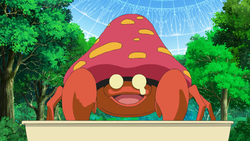

 For other sprites and images, please see Parasect images on the Bulbagarden Archives.
For other sprites and images, please see Parasect images on the Bulbagarden Archives.
